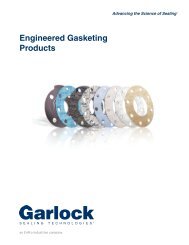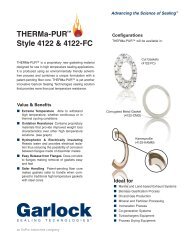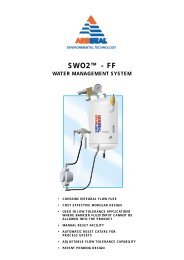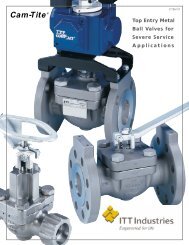expansion joints - AR Thomson Group
expansion joints - AR Thomson Group
expansion joints - AR Thomson Group
You also want an ePaper? Increase the reach of your titles
YUMPU automatically turns print PDFs into web optimized ePapers that Google loves.
MEASURING AND EVALUATING MISALIGNMENT<br />
Before any <strong>expansion</strong> <strong>joints</strong> are to be replaced,<br />
dimensions must be verified. As a result of settlement,<br />
misalignment or improper design, many elastomeric<br />
<strong>expansion</strong> <strong>joints</strong> are overstressed beyond their performance<br />
limitations. It is critical, therefore, that all<br />
measurements (flange-to-flange, lateral, torsional, and<br />
angular misalignment) be double-checked against original<br />
specifications/drawings.<br />
Flange-to-Flange Dimensions<br />
(also known as face-to-face or FF)<br />
This measurement is taken from the inside of one<br />
mating metal flange to the inside of the other – the<br />
actual opening where the <strong>expansion</strong> joint is to be<br />
inserted. This is typically the dimension most likely to be<br />
variable. For example, if the original <strong>expansion</strong> joint<br />
measured 8" FF, but the current opening measures 9-<br />
1/2" FF, it is necessary to build the <strong>expansion</strong> joint at the<br />
new FF dimension. Most elastomeric <strong>expansion</strong> <strong>joints</strong><br />
are rated for a minimal amount of elongation (1/4-1/2")<br />
and, therefore, the <strong>expansion</strong> joint would be overstressed<br />
if installed at 1-1/2" more than the manufactured<br />
dimension. This stress would begin internally as the<br />
vulcanized fabric plies began to tear apart. Evidence of<br />
such stress would be cracking/tearing at the base of the<br />
elastomeric flanges and delamination of fabric plies<br />
under pressure/vaccuum. Subjecting an <strong>expansion</strong> joint<br />
to this type of condition will shorten its life expectancy<br />
and may cause premature failure.<br />
Conversely, if an <strong>expansion</strong> joint is manufactured at<br />
8" FF, and the actual opening between the mating metalflanges<br />
is 7-1/4" FF, it is practically impossible to<br />
precompress the joint without incurring damage.<br />
Elastomeric <strong>expansion</strong> <strong>joints</strong> are designed to handle<br />
gradual axial movements as a result of thermal<br />
<strong>expansion</strong> and contraction. Forcing an <strong>expansion</strong> joint in<br />
place puts an unnatural stress on the elastomeric<br />
flanges causing internal damage, especially along the<br />
back of the flange area and the arch.<br />
The flange-to-flange dimension becomes a critical<br />
factor when replacing an <strong>expansion</strong> joint, but also, when<br />
measured accurately, may enhance the life expectancy<br />
of the product. When measured incorrectly, it may<br />
greatly reduce the performance of the <strong>expansion</strong> joint<br />
and may even contribute to a premature/catastrophic<br />
failure.<br />
8<br />
Maximum allowable misalignment is listed in Appendix,<br />
Table IV; however, greater tolerances may be permitted. It<br />
is advisable to check with the manufacturer before exceeding<br />
this industry standard.<br />
Angular Misalignment<br />
When measuring the flange-to-flange dimension, it is<br />
necessary take a minimum of four dimensions; on larger<br />
I.D. <strong>expansion</strong> <strong>joints</strong> (over 24") six to eight measurements<br />
are recommended. If measuring in four areas, they should<br />
be spaced equally around the circumference of the<br />
<strong>expansion</strong> joint (in opposing quadrants). Any variation in<br />
the dimensions taken are indicative of angular<br />
misalignment – the non-parallelism of the mating metal<br />
flanges.<br />
There are other important notations to make, if angular<br />
misalignment is present. Since one of the main difficulties<br />
in installing an <strong>expansion</strong> joint (especially on 24" I.D. and<br />
larger) is accessibility, it is valuable to indicate on the<br />
measurements taken where the access point would be. If<br />
the access point is dramatically smaller than the opposing<br />
side, the <strong>expansion</strong> joint face-to-face must be built to the<br />
access point measurement. However, the <strong>expansion</strong> joint<br />
must have the ability to extend beyond the longest face-toface<br />
flange dimension without damage. There are other<br />
ways to handle this angular misalignment; i.e. using<br />
tapered metal spacers, and realigning the piping. Be sure<br />
to contact the manufacturer for their recommendations<br />
(see Figure 7 for illustration).





![VCS Flange Gasket [1.03 MB] - AR Thomson Group](https://img.yumpu.com/12044617/1/190x245/vcs-flange-gasket-103-mb-ar-thomson-group.jpg?quality=85)

![PGE Flange Gasket Product Brochure [1.04 MB] - AR Thomson Group](https://img.yumpu.com/12044595/1/190x245/pge-flange-gasket-product-brochure-104-mb-ar-thomson-group.jpg?quality=85)





